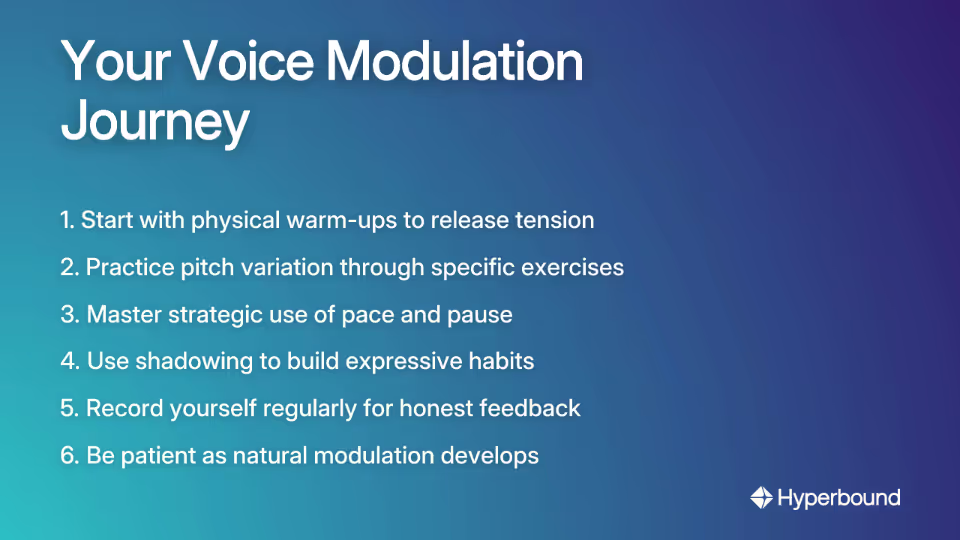
You've just finished presenting your brilliant ideas to a room of colleagues or classmates. The content was solid, your research impeccable. Yet as people file out of the room, you catch fragments of feedback: "Good information, but a bit dry..." or worse, someone stifles a yawn and mutters something about your "robot voice."
If you've ever been told your speech sounds "really flat with no voice modulation or natural pauses" or that your delivery feels "dull and robotic," you're not alone. Many people struggle with monotone speech patterns that can undermine their message and disengage their listeners—no matter how valuable their ideas might be.
Why Your Voice Matters More Than You Think
A monotone voice lacks variation in pitch, pace, and volume. It's the vocal equivalent of typing in all lowercase with no punctuation—technically readable, but missing the emotional cues and emphasis that make communication dynamic and engaging.
The good news? Voice modulation is a learnable skill, not an innate talent. With targeted practice and the right techniques, you can transform from flat to fascinating, from monotone to magnetic.
Understanding Voice Modulation: Your Communication Superpower
Voice modulation is the ability to adjust your pitch (high/low), tone (emotion), and volume during speech. When mastered, it becomes your secret weapon for:

As one Reddit user confessed, "I feel like it makes people lose interest when I'm presenting in class or talking to anyone." This common pain point highlights why mastering vocal expressiveness isn't just nice to have—it's essential for effective communication.
Foundation: Physical Warm-Ups for Vocal Freedom
Before diving into specific modulation techniques, you need to prepare your vocal instrument. Tension in your body creates tension in your voice, limiting your expressive range.
Try these essential warm-ups before important speaking engagements:
1. Breath Relaxation
- Stand with relaxed posture, hands resting on your abdomen
- Breathe deeply from your diaphragm (your stomach should expand, not your chest)
- Exhale slowly with a continuous "ssssss" sound, feeling your abdominal muscles engage
- Repeat 5-10 times to establish breath control
2. Jaw Release
- Place your fingertips on your jaw muscles near your ears
- Gently massage in circular motions while allowing your jaw to hang loose
- Make soft "mah-mah-mah" sounds to feel the relaxation
3. Lip Trills (Lip Bubbles)
- Relax your lips and blow air through them to create a "motorboat" sound
- Once comfortable, add sound to create a "brrrrr" effect
- Try varying your pitch up and down while maintaining the trill
4. Humming
- With lips gently closed, hum a simple tune
- Focus on feeling vibrations in your lips, nose, and cheekbones
- This activates your resonating chambers for a richer sound
5. Tongue Trill
- Place your tongue just behind your upper front teeth
- Exhale to create a rolling "rrrrr" sound (like Spanish)
- Challenge yourself to vary pitch while maintaining the trill
These exercises might feel silly at first, but they're scientifically proven to release tension and expand your vocal capabilities. As one voice coach notes, "These warm-ups prepare the vocal mechanism for the demands of expressive speech, much like athletes warm up before competition."

Practical Exercises to Build Vocal Variety
Now that your voice is warmed up, it's time to tackle the core elements of expressiveness: pitch, pace, and pause.
Unlocking Your Pitch Range
Many monotone speakers use only a narrow band of their natural vocal range. These exercises help you explore and expand:
The Sliding Scale Exercise
- Say the phrase: "I'm sliding UP and sliding DOWN in pitch."
- As you say "up," slide your voice to a higher note
- As you say "down," slide to a lower note
- Exaggerate initially, then practice with increasing subtlety
The Emotion Shift
- Take a simple sentence: "I need to talk to you."
- Say it as if you're:
- Excited about good news
- Disappointed by a setback
- Suspicious of deception
- Confused by a statement
- Notice how your pitch naturally varies with emotional intent
Mastering Pace and the Power of Pause
A truly dynamic approach to speech involves strategic variations in speed and strategic silences.
The Highlighter Method
- Take any paragraph of text
- Highlight words or phrases you want to emphasize
- When reading aloud, slow down slightly on highlighted words
- Insert a brief pause before or after key points
- Speed up slightly during less important connecting phrases
As noted by a leading communication expert, "The pause is one of the most underutilized yet powerful tools in speech. It gives the listener time to process, creates anticipation, and signals importance."
Word Stress Exercise
Take this sentence: "I didn't say she stole the money."
Say it seven times, each time stressing a different word. Notice how the entire meaning shifts based on which word you emphasize:
- "I didn't say she stole the money." (Someone else said it)
- "I didn't say she stole the money." (I never said that)
- "I didn't say she stole the money." (I implied it)
This exercise dramatically demonstrates how voice modulation changes meaning—not just delivery style.
Real-World Application: Mimicry and Practice
Theory alone won't transform your speech. You need to apply these techniques in realistic scenarios.
Shadowing: Your Secret Weapon
One of the most effective techniques recommended by successful communicators is "shadowing"—closely mimicking expressive speakers.
- Find a 30-60 second clip of an engaging speaker (TED talks work well)
- Listen once to absorb their style
- Play it again, this time repeating their exact words, matching:
- Pitch variations
- Pace changes
- Natural pauses
- Speech clarity and articulation
As one Reddit user who overcame monotone speech shared: "Shadowing short clips from YouTube or Netflix helped me develop a rhythm and flow I couldn't find on my own." This technique builds muscle memory for expressiveness that gradually becomes natural.
The Over-Emoting Method
Many monotone speakers hold back due to fear of sounding "too much." The solution? Practice in private with deliberate exaggeration.
As another Reddit user brilliantly suggests: "Practice over-emoting in private. Go nuts, pull faces, project your voice cartoonishly, speak in sing-song, Jim Carrey stuff. You'll sound goofy, but you need to train yourself to be more expressive."
This approach works because it:
- Breaks ingrained habits of restraint
- Expands your comfort zone
- Helps you find your authentic "middle ground"
- Adds a touch of pizzazz to formerly flat delivery
Acting Out Scenes
Reading prose aloud "as if you were acting" is another powerful recommendation from those who've successfully overcome monotone speech. Choose dialogues with emotional content and try:
- Reading with different character voices
- Adding appropriate emotional inflection
- Including physical gestures that match the tone
- Recording yourself for self-assessment
Integration: Mind, Body and Feedback
Connect Voice to Body Language
Your voice doesn't exist in isolation—it works in concert with your physical presence. Try these integration techniques:
- Use purposeful hand gestures to emphasize key points
- Allow facial expressions to match your vocal tone (a smile can literally be "heard")
- Stand with confident posture to support proper breathing
- Move deliberately to punctuate important statements
Recording: Your Honest Coach
Perhaps the most crucial tool for improvement is the recording device in your pocket. Regular recording and review creates the feedback loop essential for improvement:
- Record yourself speaking naturally for 1-2 minutes
- Listen back with specific focus on pitch, pace, and pause
- Identify one specific element to improve
- Practice that element, then record again
- Note improvements and choose the next focus area
Leverage Technology and Coaching for Faster Results
For personalized feedback and interactive practice, modern tools and traditional methods can accelerate your progress:
- Practice with AI: Platforms like Hyperbound offer AI-powered roleplays that let you practice critical conversations and receive instant, objective feedback on your voice modulation, pitch, and pacing. It's a safe, scalable way to build confidence before high-stakes interactions.
- Join a community: Groups like Toastmasters provide regular speaking opportunities in a supportive environment.
- Take an improv class: This can help develop spontaneous expressiveness and comfort with thinking on your feet.
- Work with a voice coach: A professional coach can provide targeted, 1:1 technique refinement.
The Path Forward
Overcoming monotone speech isn't an overnight transformation—it's a journey of consistent practice and gradual improvement. As you implement these techniques, remember:

With dedication to these practices, you'll develop a voice that engages, influences, and authentically expresses your ideas with all the color and depth they deserve. No more "robot voice"—just you, communicating with clarity, confidence, and the natural pizzazz that turns listeners into fans.
Your voice is your most portable tool for influencing others. By mastering voice modulation, you don't just fix a monotone delivery—you unlock your full potential as a communicator.
Frequently Asked Questions
What is voice modulation and why is it important?
Voice modulation is the skill of varying your pitch, tone, and volume while speaking to make your communication more dynamic and engaging. It's important because a modulated voice helps capture and maintain listener interest, enhances the clarity of your message, builds rapport, and projects authenticity, preventing your ideas from being perceived as "dry" or "dull."
How can I stop my voice from sounding monotone?
You can stop your voice from sounding monotone by consistently practicing specific vocal exercises to increase your expressive range. Key practices include physical warm-ups like lip trills and humming, exercises to expand your pitch range like the "sliding scale," and mastering the use of pace and strategic pauses. Techniques like shadowing engaging speakers and recording yourself for feedback are also highly effective.
What is the fastest way to improve voice modulation?
The fastest way to improve voice modulation is through focused, consistent practice combining self-recording and a powerful technique called "shadowing." Shadowing involves mimicking short clips of expressive speakers to build muscle memory for vocal variety. For even faster, targeted feedback, using AI-powered coaching tools can accelerate your progress by providing instant analysis on your pitch, pace, and volume.
Can anyone learn to modulate their voice?
Yes, anyone can learn to modulate their voice. Voice modulation is a learnable skill, not an innate talent. While some people may be naturally more expressive, anyone can expand their vocal range and overcome a monotone delivery through targeted exercises, consistent practice, and releasing physical tension that restricts the voice.
How long does it take to fix a monotone voice?
Fixing a monotone voice is a gradual process, and the timeline varies for each individual. With consistent daily practice of about 15-20 minutes, you can start noticing improvements in your awareness and control within a few weeks. Achieving a naturally expressive delivery that feels authentic may take several months of dedicated effort. Consistency is more important than the duration of each practice session.
What are some simple warm-ups I can do before a presentation?
Before a presentation, you can perform several simple warm-ups to prepare your voice. These include deep diaphragmatic breathing to control airflow, gentle jaw massages to release tension, lip and tongue trills to increase flexibility, and humming to activate your vocal resonators for a richer sound. These exercises help ensure your voice is relaxed, flexible, and ready for expressive speech.

Book a demo with Hyperbound
.png)













